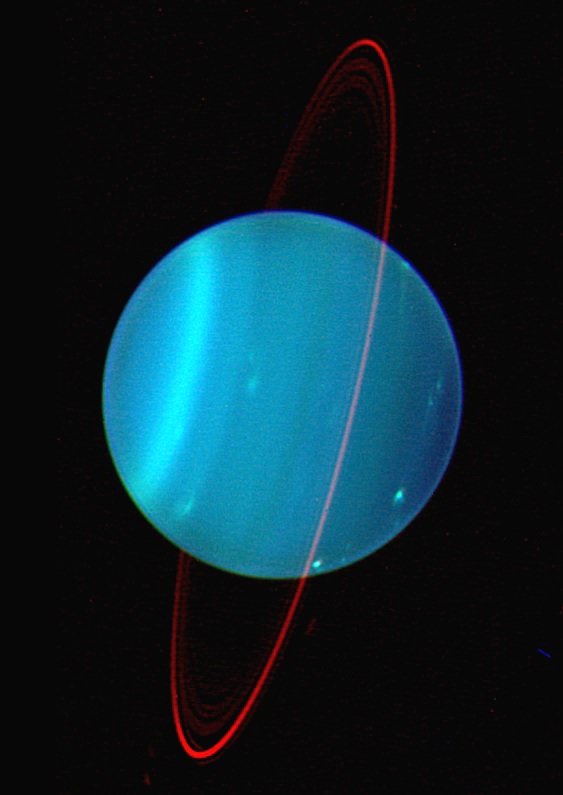[/caption]
Popular theory on how Uranus ended up with a highly eccentric axis has always been pretty standard – one giant blow. However, at today’s (October 6) EPSC-DPS Joint Meeting in Nantes, astronomers are thinking things may have occurred slightly differently. Instead of a singular impact, the glowing blue-green gas giant may have been the victim of a series of smaller punches.
At a 98 degree inclination, Uranus and its satellites have always been somewhat of a mystery to planetary scientists. While many of the Solar Systems planets have an inclined axis, none can compare with nearly being on its side. It has always been popular conjecture that Uranus was plastered that way at some point in its evolution by a body a few times larger than Earth. While this seems plausible, only one hole remains in the theory. Why did its moons take on the same inclination instead of staying in their original position?
This long-standing puzzle may have been solved by an international team of scientists led by Alessandro Morbidelli (Observatoire de la Cote d’Azur in Nice, France). Their theory relies on computer modeling – and the thought the impact might have occurred while Uranus was still forming. If the simulations are correct and the strike happened when the planet was still surrounded by a protoplanetary disk, ” the disk would have reformed into a fat doughnut shape around the new, highly-tilted equatorial plane. Collisions within the disk would have flattened the doughnut, which would then go onto form the moons in the positions we see today.”
But that’s not a neat answer. Just like throwing a tilt into pinball, the game changes. In this new scheme, the moons displayed retrograde motion – precisely the opposite of the way things are now. So what’s a player to do? Change the game again by re-arranging the parameters. By adding multiple strikes to Uranus – instead of just one large – the satellites now behave as we observe them.
Of course, when you “tilt” the game is over, and the new research doesn’t jive with current theories of planetary formation. This may mean re-writing the rules again. Morbidelli elaborates: “The standard planet formation theory assumes that Uranus, Neptune and the cores of Jupiter and Saturn formed by accreting only small objects in the protoplanetary disk. They should have suffered no giant collisions. The fact that Uranus was hit at least twice suggests that significant impacts were typical in the formation of giant planets. So, the standard theory has to be revised.”
That deaf, dumb and blind kid… Sure plays a mean pinball!
Original Story Source: Europlanet News Release.


you really do learn something new every day. cool.
But the giants have migrated, and the new migration scenarios tells about possibilities for exchanging acquired eccentricities for tilt (I think). The most obvious example is Venus which has tilted to become retrograde,* yet has no impact scars or moons to tell about it. (As opposed to Earth and Mars.)
Seeing how the impact scenarios becomes complicated, do they really compete?
————–
* Or possibly, as I recently read and understood it, that its inner viscous dynamics may have halted and reversed spin.
New Scientist magazine, 1 Oct 2011, pg 14, “This Week” has an article about computer modeling our early Solar System with either four or five gas giants. The five gas giant simulation best matched the current configuration of Jupiter, Saturn, Uranus and Neptune. The fifth gas giant formed between Saturn and Uranus. It was ejected into interstellar space through gravitational interaction (resonance) with Jupiter. Jupiter therefore lost angular momentum moving outward. Uranus and Neptune, too, disrupting the Oort cloud/Kuiper belt causing the inner Solar System late bombardment. Perhaps this activity tilted Uranus with its retrograde moons?
That’s interesting. Ejecting a gas giant would be hard, I would think. Would it get enough momentum to overcome the Sun’s gravity well?
What if it simply moved into an extremely elongated orbit? If so, shouldn’t we have detected it by now?
If there is enough energy available to send it into an elongated orbit, then just a little more energy sends it on an escape route.
As a comparison, microlensing scenarios have the number of free-floating, ejected, giants as roughly the same as those still bound to stars.
As a comparison, microlensing scenarios have the number of free-floating, ejected, giants as roughly the same as those still bound to stars.
Tammy, how do you think he does it? I don’t know! What makes him so good?
Would the moons have remained in their original positions? Surely tidal forces would have pulled the original moons firstly into chaotic orbits, where they might have collided and reformed, then settled into more stable equatorial orbits?